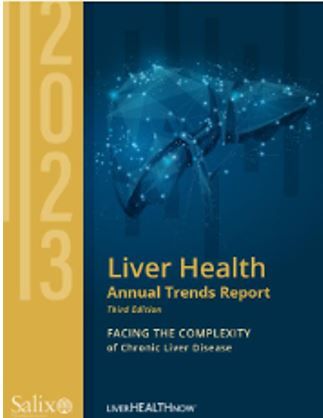Chronic Liver Disease Prevalence May Triple by Decade's End, New Report Projects
Chronic liver disease- (CLD) related mortality could potentially triple by the end of the decade, according to findings published in the third annual Liver Health Annual Trends Report from Salix Pharmaceuticals, a prediction made even more ominous by additional study results that expose chronic staffing shortages among health care specialists including gastroenterologists and hepatologists, as well as among frontline primary care clinicians.
Liver Health Annual Trends Report: Facing the Complexity of Chronic Liver Disease
Courtesy Salix Pharmaceuticals
Courtesy Salix Pharmaceuticals

The report is based on a survey of 400 health care professionals (HCPs) who treat CLD, qualitative interviews with HCPs and secondary research from peer-reviewed publications.
"Over its first three editions, the Salix Liver Health Trends Report has described the enduring disparities and tremendous burden seen across the treatment of chronic liver disease," said Nicola Kayel, senior vice president, Marketing, Salix, in a company statement. "The report makes clear that increased education and awareness on the issues facing CLD care, as well as distinct and practical treatment guidelines are vital tools to help health care providers improve CLD management and provide for better experiences and outcomes for people living with CLD."
Indeed, the survey revealed that nearly one-third (31%) of respondents are unaware of national guidelines for the management of CLD.
Prevalence and mortality rising
CLD is comprised of nonalcoholic fatty liver disease (NAFLD) and nonalcoholic steatohepatitis (NASH). NAFLD is the most common causes of liver disease in the United States and in 2021, according to the report, prevalence of CLD and the more advanced hepatic cirrhosis, increased 9% over the previous year, elevating them to the ninth leading cause of death in the US. Contributing to increases in both prevalence and mortality are dual surges in chronic diseases known to be risk factors for hepatic steatosis—type 2 diabetes and obesity. The COVID-19 pandemic contributed significantly to poor outcomes, with a reported increase in alcohol-associated liver disease (ALD) deaths of 22.4% (2020 versus 2019). For the first time, moreover, ALD accounted for more liver transplant wait-listings (40.1%) than hepatitis C virus (12.4%) and NASH (23.4%) combined, according to the report.
As these numbers rise, gastroenterologists report a 32% increase in CLD patients and a 54% increase in patients with cirrhosis they see per month. The primary research contributing to the final report identifies socioeconomic factors and staffing shortages as contributing to the challenge of providing adequate care, especially in rural and underserved areas. Chronic low staffing was reported by 72% of clinicians surveyed and across levels of care; 80% reported shortages in nursing staff, 29% said gastroenterologists were needed, and 26% reported low numbers of hepatologists. Health care resources are also disproportionate by geography, according to respondents, 43% of whom working in rural settings reported shortages of primary care clinicians as compared to 28% of those located in an urban/suburban setting. The report also found that the average wait to establish care with a specialist is 13.1 weeks but can be as long as nearly 12 months is some rural areas.
Complete findings from Salix's Liver Health Annual Trends Report as well as health care provider resources to help identify and manage patients with CLD and cirrhosis can be viewed at LiverHEalthNow.com.